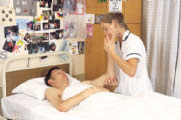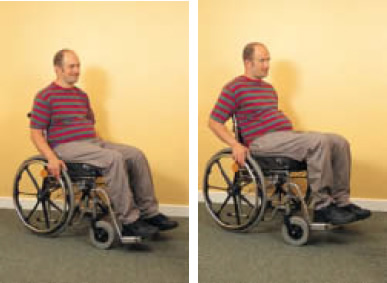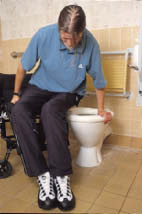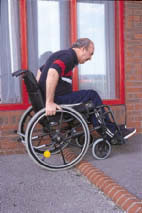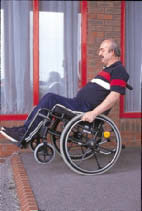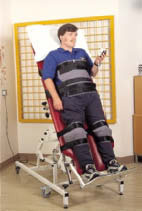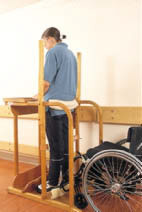Physiotherapy after spinal cord injury
Physiotherapy assessment and treatment should be carried out as soon as possible after injury. During the early acute stage, care of the chest and paralysed limbs is of prime importance. Chest complications may occur as a result of the accident — for example, from inhaling water during diving incidents, from local complications such as fractured ribs, or from respiratory insufficiency caused by the level of the injury. Pre-existing lung disease may further complicate respiration.
Respiratory management
All patients receive prophylactic chest treatment, which includes deep breathing exercises, percussion and coughing, assisted if necessary. Careful monitoring is essential for tetraplegic patients as cord oedema may result in an ascending level of paralysis, further compromising respiration.
Patients with tetraplegia or high level paraplegia may have paralysed abdominal and intercostal muscles and will be unable to cough effectively. Assisted coughing will be necessary for effective lung clearance. Careful coordination and communication between physiotherapist and patient is vital for assisted coughing to be successful. Forced expiration may be achieved by the placement of the therapist’s hands on either side of the lower ribs or on the upper abdomen and ribs, producing an upward and inward pressure as the patient attempts to cough. Two people may be needed to treat the patient with a wide chest or tenacious sputum.
Passive movements
All paralysed limbs are moved passively each day to maintain a full range of movement. Loss of sensation means that joints and soft tissues are vulnerable to overstretching, so great care must be taken not to cause trauma. Provided that stability of the bony injury is maintained, passive hip stretching with the patient in the lateral position, and strengthening of non- paralysed muscle groups, is encouraged.
Once the bony injury is stable patients will start sitting, preferably using a profiling bed, before getting up into a wheelchair. This is a gradual process because of the possibility of postural hypotension, which is most severe in patients with an injury above T6 and in the elderly.
Mobilisation into a wheelchair
Once a patient is in a wheelchair regular relief of pressure at the ischial, trochanteric, and sacral regions is essential to prevent the development of pressure sores in the absence of sensation. Patients must be taught to lift themselves to relieve pressure every 15 minutes. This must become a permanent habit. Paraplegic patients can usually do this without help by lifting on the wheels or arm rests of their wheelchairs. Tetraplegic patients should initially be provided with a cushion giving adequate pressure relief, but may in time be able to relieve pressure themselves.
Wheelchairs
Wheelchair design has been much influenced by technology. Lightweight wheelchairs are more aesthetically acceptable, considerably easier to use, and often adjustable to the individual user’s requirements. An appropriate wheelchair should be ordered once an assessment of the patient’s ongoing needs has been made.
Gait expectations of patients with complete paraplegia: all patients should be totally independent with all transfers and chair manoeuvres both indoors and outdoors.
| Level of injury | Gait used | Descriptions |
| T1–T8 | Gait — swing to with calipers and rollator May use crutches if spasticity is controlled |
Swing to gait is the easiest type of gait to achieve but is slow and used only as an exercise. The patient puts the crutches a short distance in front of the feet and leans forward on to the crutches. He or she then pushes down with the shoulders, which lifts both legs together. The feet must land behind the crutches. It is a short, sharp lift. Prolonging the lift will make the feel go past the crutches and the patient will lose balance and fall. |
| T8–T10 | Swing to and swing through gait with full length calipers and crutches Walking more likely to be an exercise rather than fully functional |
Swing through gait is for speed and is the most functional for walking outside. However, it does expend a lot of energy. The patient places the crutches about 18 inches in front of the feet and leans forward on to the crutches; he or she then pushes the shoulder down, which raises both feet off the floor together. The lift must be maintained so that the feet are placed the same distance in front of the crutches as they started behind. As the feet touch the floor the patient must retract the shoulders to extend the hips and hence remain balanced. |
| T10–L2 | Swing through and four point with calipers and crutches Requires wheelchair for part of day — walking may be fully functional |
|
| L2–L4 | Below knee calipers with crutches or sticks Wheelchair not required |
Four point gait is the most difficult and requires excellent balance and strong shoulders and trunk. It is the nearest equivalent to a normal gait, but is very slow. The patient moves one crutch forward, transfers body weight on to the adjacent leg, and then moves the opposite leg forward by using latissimus dorsi to "hitch" the hip. The step must be short; if too large a step is taken the patient will fall, as he or she cannot recover balance. |
| L4–L5 | May or may not require calipers Wheelchair not required May require sticks or other walking aid |
Right: patient seated incorrectly — "slumped" and with poor trunk posture. Footplates are too high so there is excessive pressure on the sacrum — a potential pressure problem.
Rehabilitation
Physical rehabilitation includes the following:
- Familiarity with the wheelchair. The patient has to be taught how to propel the chair, operate the brakes, remove the footplates and armrests, and fold and transport the wheelchair. Basic skills include pushing on level and sloping ground and turning the chair
- Relearning the ability to balance. The length of time this takes will depend on the degree of loss of proprioception and on trunk control
- Strengthening non-paralysed muscles
- Learning to transfer from wheelchair to bed, toilet, bath, floor, easy chair, and car. Teaching these skills is only possible once confidence in balance is achieved and there is sufficient strength in the arms and shoulder girdles. The degree of independence achieved by each patient will depend on factors such as the level of the lesion, the degree of spasticity, body size and weight, age, mental attitude, and the skill of the therapist. Patients who cannot transfer themselves will require help, and patient and helpers will spend time with therapists and nurses learning the techniques for pressure relief, dressing, transferring, and various wheelchair manoeuvres. The level of independence achievable by tetraplegic patients is shown on page 55 in chapter 10. Close cooperation between physiotherapists and occupational therapists helps patients to reach their full potential
- Learning advanced wheelchair skills: backwheel balancing to allow easier manoeuvrability over rough ground and provide a means of negotiating kerbs; jumping the chair sideways for manoeuvrability in a limited space; and lifting the wheelchair in and out of a car unaided
- Regular standing, may help to prevent contractures, reduce spasticity, and minimise osteoporosis. In patients subject to postural hypotension the vertical position must be assumed gradually, and patients may be helped by the use of an abdominal binder. For these patients the tilt table is used initially, progressing later, if appropriate, to an Oswestry standing frame or similar device
Patients with low thoracic or lumbar lesions may be suitable for gait training using calipers and crutches, but success will depend on the patient’s age, height, weight, degree of spasticity, and attitude. Orthotic devices such as the reciprocating gait orthosis (RGO), advanced reciprocating gait orthosis (ARGO), hip guidance orthosis (HGO), or Walkabout may be considered for patients including those unsuitable for traditional calipers and crutches. Instruction in the use of these devices requires specialist input and checks should be made on the patients and their orthoses at regular intervals.
Recreation
Sporting activities can be a valuable part of rehabilitation as they encourage balance, strength, and fitness, plus a sense of camaraderie and may well help patients reintegrate into society once they leave hospital. Archery, darts, snooker, table tennis, fencing, swimming, wheelchair basketball, and other athletic pursuits are all possible and are encouraged.
Incomplete lesions
Patients with incomplete lesions are a great challenge to physiotherapists as they present in various ways, which necessitates individual planning of treatment and continuing assessment. Patients with incomplete lesions may remain severely disabled despite neurological recovery. Spasticity may restrict the functional use of limbs despite apparently good isolated muscle power. The absence of proprioception or sensory appreciation will also hinder functional ability in the presence of otherwise adequate muscle power. Patients with a central cord lesion may be able to walk, but weakness in the arms may prevent them from dressing, feeding, or protecting themselves from falls. Recovery may well continue over several months, if not years, so careful review and referral to the patient’s district physiotherapy department may be necessary to enable full functional potential to be achieved.
Children
Spinal cord injury in children is rare. The most important principles in the physical rehabilitation of the growing child with a spinal cord injury are preventing deformities, particularly scoliosis, and encouraging growth of the long bones. To achieve these aims the child requires careful bracing and full-length calipers to maintain an upright posture for as much of the day as possible. The child should be provided with a means of walking such as brace and calipers with crutches or rollator, a swivel walker, hip guidance orthosis, or reciprocating gait orthosis.
Sitting should be discouraged to prevent vertebral deformity. A wheelchair should be provided, however, to facilitate social activity both in and out of the home. Return to normal schooling is encouraged as soon as possible.
Young children have arms that are relatively short in relation to the trunk, so they should not attempt independent transfers. The child may therefore need to be readmitted and taught transfer skills at a later stage. Continued follow up is necessary throughout childhood, adolescence, and early adult life to ensure that adjustments are made to braces, calipers, and wheelchair to maintain good posture and correct growth.
See also
- At the accident:
- History and epidemiology of spinal cord injury
- Spinal injuries management at the scene of the accident
- Evacuation and initial management at hospital:
- Evacuation and transfer to hospital of patients with spinal cord injuries
- Initial management of patients with spinal cord injuries at the receiving hospital
- Neurological assessment of patients with spinal cord injuries
- Spinal shock after severe spinal cord injury
- Partial spinal cord injury syndromes
- Radiological investigations:
- Initial radiography of patients with spinal cord injuries
- Cervical injuries
- Thoracic and lumbar injuries
- Early management and complications of spinal cord injuries — I:
- Respiratory complications
- Cardiovascular complications
- Prophylaxis against thromboembolism
- Initial bladder management
- The gastrointestinal tract
- Use of steroids and antibiotics
- The skin and pressure areas
- Care of the joints and limbs
- Later analgesia
- Trauma re-evaluation
- Early management and complications of spinal cord injuries — II:
- The anatomy of spinal cord injury
- The spinal injury (cervical, thoracic and lumbar spine)
- Transfer to a spinal injuries unit
- Medical management in the spinal injuries unit:
- The cervical spine injuries
- The cervicothoracic junction injuries
- Thoracic injuries
- Thoracolumbar and lumbar injuries
- Deep vein thrombosis and pulmonary embolism
- Autonomic dysreflexia
- Biochemical disturbances
- Para-articular heterotopic ossification
- Spasticity
- Contractures
- Pressure sores
- Urological management of patients with spinal cord injury:
- Nursing for people with spinal cord lesion:
- Physiotherapy after spinal cord injury:
- Respiratory management
- Mobilisation into a wheelchair
- Rehabilitation
- Recreation
- Incomplete lesions
- Children
- Occupational therapy after spinal cord injury:
- Hand and upper limb management
- Home resettlement
- Activities of daily living
- Communication
- Mobility
- Leisure
- Work
- Social needs of patient and family:
- Transfer of care from hospital to community:
- Education of patients
- Teaching the family and community staff
- Preparation for discharge from hospital
- Easing transfer from hospital to community
- Travel and holidays
- Follow-up
- Later management and complications after spinal cord injury — I:
- Late spinal instability and spinal deformity
- Pathological fractures
- Post-traumatic syringomyelia (syrinx, cystic myelopathy)
- Pain
- Sexual function
- Later management and complications after spinal cord injury — II:
- Later respiratory management of high tetraplegia
- Psychological factors
- The hand in tetraplegia
- Functional electrical stimulation
- Ageing with spinal cord injury
- Prognosis
- Spinal cord injury in the developing world:


